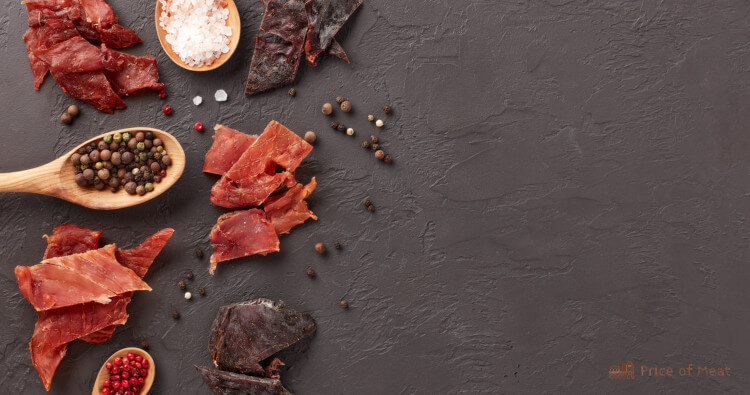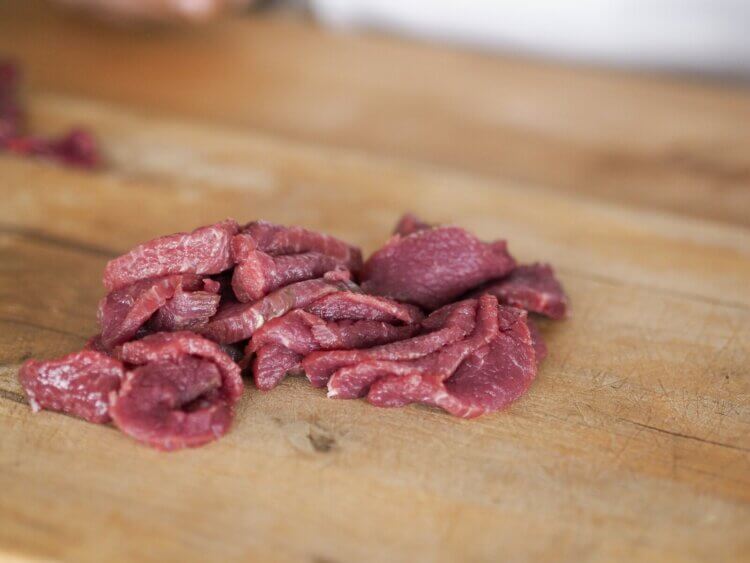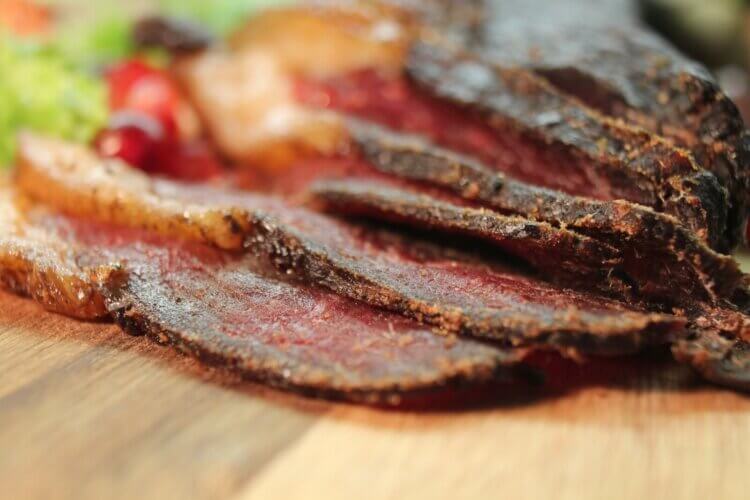How Much Per Oz for Beef Jerky

Why is beef jerky so expensive? Several factors go into the cost of this famous meat treat, but most of it ultimately comes down to water weight. Here is what's going on.
The Process Of Making Jerky
Making jerky is a five-step process, although different manufacturers have different techniques.
Step 1: Choosing and Slicing

The first step is choosing and slicing the raw meat. Jerky cuts go against the grain, but it's possible to make jerky from almost any whole-muscle cut of lean beef. This is the first point where beef prices vary, as national beef pricing reports show. The starting raw beef costs for jerky made with rump roast, for example, is less than half the starting price of a better cut like filet mignon or skirt steak.
There are many potential options for making beef jerky, and some of them are easier to acquire than others.
Step 2: Marinating
The next step in making jerky is marinating. This is yet another point where pricing can vary, too, based on the ingredients for a particular recipe. Beef jerky requires a certain amount of marinade by volume, but using rarer or higher-quality ingredients can significantly increase the ultimate cost of production.
Step 3: Laying the Meat
The third step in production is laying the meat, which means putting it on racks and preparing to cook it. Laying the beef requires paying an employee for their time but ultimately has a minimal impact on the cost of making jerky.
Step 4: Cooking and Drying

The fourth step is the real impact on cost. Cooking and drying often happen together when making beef jerky, and it's usually better if the meat cooks at a low temperature for a long time. However, while it's drying, the beef will lose a lot of its water weight.
Recipes and proportions vary slightly, but an average piece of beef will lose at least half its weight in the drying process, and often two-thirds. Functionally, this means three pounds of meat becomes one pound of jerky (same if you are shredding it further)
This is an obvious problem for manufacturers. Buy 2-3 times as much beef as you want to sell weight-wise.
That means the price of beef jerky has to be high enough to cover not just that lost weight but your company's profits. If you spend $10 a pound for flank steak, you may need to sell at more than $30 a pound to make a profit.
More than anything else, the type of meat you're buying and the drying process are what affect the price of beef jerky.
The final step in making finished jerky is packaging, which is generally affordable. Beef jerky requires airtight packaging for freshness, but beyond that, your options are pretty open.
What About Exotic Jerky?
Exotic jerky making follows the same process, but it has a higher base cost than regular beef jerky because the ingredients are harder to get. Meats like alligator, ostrich, salmon, trout, yak, bison, elk, moose, bear, and even rattlesnake are more expensive than beef. They certainly will not be cheap jerky.
Note that some types of meat may lose more or less water than beef in the drying process, affecting the overall cost of production.
Equipment: The Dehydrator
There are plenty of great dehydrators on the market, with options ranging from at-home machines to commercial-level bulk dehydrators. If you're asking "why is beef jerky so expensive?" – this is the most significant secondary consideration beyond the meat and drying.
Specifically, if you're selling jerky, you need to ensure you're making enough money to cover the cost of buying, operating, and maintaining your dehydrator. Naturally, the more you make and sell, the easier it is to cover this cost. Same goes with a good jerky slicer.
For at-home jerky makers, a simple dehydrator will probably cost more than $120, and this rarely includes a cooking function. Anywhere lower than this is probably too cheap for what you're trying to do. An oven/dryer combination machine with more space inside will be $600+. Commercial machines will be several thousand dollars.
Other Factors Affecting The Price Of Beef Jerky
The factors above are the principal reasons that jerky is so expensive, but there are some other considerations to keep in mind that have an impact.
Cooking and Drying Time
Drying itself is a primary driver for cost when making beef jerky, but drying time also matters. The time comes into play on two levels.
The first level is that companies need to have someone monitoring the jerky while it's drying. It usually takes at least five hours to make good beef jerky, so companies need to pay at least one employee during that time. Fortunately, one employee can monitor multiple machines, so producing beef jerky in bulk reduces the cost of needing an employee.
The second reason drying time matters is that it's possible to dehydrate beef jerky too much. If the water level goes down too far, the jerky is ruined and no longer a delicious treat. Home creators can budget for the occasional ruined batch, but commercial companies making hundreds of pounds of jerky at a time would suffer a significant loss.
Cooking time also involves electricity costs, although these are lower than you might expect. Jerky cooks at a low temperature to ensure the moisture evaporates, so even large machines use much less electricity than similar-size units that bake bread or other items at higher temperatures.
Inspections
Another factor affecting the price of beef jerky is the cost of inspections and government regulations. Private makers can avoid this, but companies need to implement entire quality-control strategies, complete with third-party testing to ensure compliance with all food safety laws.
Inspection pricing is an acceptable cost for businesses producing beef jerky in sufficient quantities, but it's big enough that companies also have to factor it into their pricing.
Shipping Costs
Most manufacturers want to keep shipping costs as low as possible, so they prefer to operate close to beef sources. That's not always possible, though, so companies may need to pay for shipping meat across the country, then again to ship it out to stores and sell it.
That sounds like an intimidating cost at first, but this isn't as relevant as you might think. The reason is that the average price of beef at stores already includes the shipping costs. In that sense, you could call shipping a hidden cost that jerky manufacturers are already paying.
However, large companies may end up paying this separately if they're buying beef in large quantities. Smaller businesses can often partner with a local butcher shop that orders and processes the beef, then cuts and prepares it.
Beef Quality
We touched on this earlier. Like shipping, the quality of beef hides in the cost of each cut of meat a manufacturer buys.
However, most beef jerky manufacturers prefer getting more-expensive cuts of beef, and there's a good reason for this. Low-quality meat produces low-quality jerky, but you won't save much on production costs if you get low-quality beef. Production is essentially a fixed cost per volume, with the quality of ingredients being meaningless when calculating it.
Put simply, that means it's usually better to get good meat and make great jerky, rather than getting poor beef and making lousy jerky. Customers will always prefer better cuts, and they'll avoid brands that are using lower-quality beef.
The result of this market tendency is beef jerky becoming a luxury product. Nobody wants to pay premium pricing for a bad product.
Marinades and Spices
The cost of seasoning beef jerky can vary greatly. Some companies use simple recipes with only a few cheap ingredients, while others get rare or exotic spices to create unique flavors.
Common spices include salt, black pepper, onion powder, brown sugar, pepper flakes, paprika, liquid smoke, Worcestershire sauce, paprika, garlic powder, and soy sauce (similar to a brisket rub).
Companies making exotic flavors might add alcohols like rum, various citrus juices, or maple syrup.
Marinades can work with a great variety of flavor combinations, but companies usually prefer simple and common flavors like teriyaki or pepper. Complex flavors are more common for small-batch products.
Marinating is more complicated than it may seem at first. The ideal marinating time ranges from an hour to almost two days, depending on the ingredients. Getting a marinade wrong can lead to spoiling the meat, so you may have to test recipes carefully to find the best way to use them.
The USDA does not recommend reusing marinades. Doing so significantly increases the chances of cross-contamination and bacterial growth that can ultimately ruin jerky. Buying fresh ingredients for marinades thus becomes part of jerky's ongoing costs.
Most companies prefer to marinate their meat in shallow layers and maximize the amount of beef the marinade can cover. Wasted space requires more marinade, which causes significantly higher costs for manufacturers.
Spices are like liquids and other ingredients for marinades. Companies typically use a lot of spices when marinading because too little for the volume means it won't provide enough flavor. If you were to measure spices by the cup, you'd end up going through them quickly.
Some companies avoid this cost entirely by minimizing or avoiding marinades. These often hit the market as "natural" beef jerky, but it's one of the few areas where companies can realize significant savings.
Product Volume
Aside from everything else, beef jerky is more affordable to make in larger volumes. There are some fixed costs, like the price of meat, drying time, and paying employees to cut and prepare the beef. However, cooking and drying take about the same amount of time whether you're doing a few pounds or a few hundred pounds.
Essentially, economies of scale can lower the price of producing beef jerky. These costs are why small-batch manufacturers always have higher prices than big-brand competitors, even if they're starting with the same cut and quality of meat.
The Real Cost Of Beef Jerky
As you can see from the explanations above, many factors affect the actual cost of beef jerky. Looking at prices around the country, you can see how these costs factor into the price per ounce.
The most affordable jerky is usually around $1 per ounce. Chances are you won't see anything meaningfully below this, no matter how hard you look.
Cheaper beef jerky usually has little or no additional flavor to it. Cutting out the marinade process reduces production time and the cost of ingredients, offering genuine savings. However, companies will often add a little smoke flavor, even for otherwise-simple recipes.
Try online retailers like Crowd Cow or FarmFoods to find high quality, grass-fed beef jerky at low prices.
Beef jerky with mild and simple marinades tend to cost at least $1.50 per ounce. This is where you'll start to get more flavors and variety in the meat, so many of the larger manufacturers end up in this range.
Small batch manufacturers usually charge between $2.50 and $5 per ounce. They can't take advantage of the economies of scale, so they have to price the meat high enough to make a profit.
For context, there are sixteen ounces in a pound of beef. Many companies use Top Round cuts for their jerky, which costs a little over $5 per pound at the pricing we linked earlier. That's about 31 cents per ounce of meat, so a company selling beef jerky for about $2.50 an ounce is selling it for 7x what they bought it for.
Shopping Smart
So, why is beef jerky so expensive? There's a hard minimum on how much you can reduce the price while still making a satisfactory product. You have a 2-3x multiplier in costs just from the loss of water weight in drying, and that's before expenses like marinades, employee working hours, and packaging.
You can reduce costs somewhat if you buy beef jerky online, especially if you buy enough to qualify for free shipping programs. Most beef jerky is shelf-stable for at least one year, so you can buy a lot at once and store it for a long time. If you buy directly from manufacturers, you can cut out middleman markups.
FAQs About Why Beef Jerky Is So Expensive
Here are a few FAQs about Why Beef Jerky Is So Expensive.
Why does beef jerky cost so much money?
Beef jerky is made from whole cuts of meat, so it takes a lot of time and effort to make. It also requires a lot of seasoning and special care to preserve. That's why beef jerky is often more expensive than other types of dried meat snacks.
Is it expensive to make beef jerky?
It's very expensive at the beginning, since you'll need decent tools to make a delicious beef jerky. Also, you'll be buying beef, and raw ingredients like spices at full retail prices. You will be making small batches at home, depending on your beef jerky recipe. Like gardening, if you stick with the hobby long-term, you can bring per-batch costs down so it's not too expensive. However, you will likely never compete with jerky sold in bulk by companies making it at scale.
What is the markup on beef jerky?
The markup on beef jerky is around 37% to 50%. This means that a $9 bag of jerky usually goes wholesale for $6. Now, the markup depends on the retailer and their pricing strategy. You will likely only find 37% markup at online retailers and large grocery stores. The smaller the retailer, the higher their markup since their inventory & capital costs are higher. Gas stations may mark a bag up 60% to 100%.
Why is there so little beef jerky in a bag?
Beef jerky settles in the bag even more than chips, it also requires more space for effective sealing at the beef jerky production facility.
Is beef jerky worth the money?
Yes, beef jerky is worth the money because it is a high-protein, healthy and convenient snack food. It is made of 100% pure beef that has been trimmed of fat and cut into thin strips. Then it is slowly cooked until it is dry and hard. This process makes a durable, portable and tasty snack that will last for weeks.
Is homemade beef jerky worth it?
It depends on the quantity and price of beef, availability and accessibility of a dehydrator, time, experience in processing meats into jerky. If you stick with the hobby and are a true beef jerky lover, you can decrease your per batch costs and make custom jerky to your taste for less money. However, your first few batches will be quite expensive.
Why is beef jerky so expensive at gas stations?
Beef jerky is expensive at gas stations because it is a high-value, low-volume item. The cost of the meat and the processing required to turn it into jerky drives up the price. Additionally, most gas stations have limited inventory space, so they cannot get the same wholesale pricing as large discount chains.
Final Thoughts
Beef jerky is always expensive, regardless of whether you're making it at home or buying it at the store. Higher-quality products offer a real difference in flavor, though, so ultimately you'll need to decide what price range you want to focus on.
Source: https://www.priceofmeat.com/2505/why-beef-jerky-is-so-expensive/
0 Response to "How Much Per Oz for Beef Jerky"
Post a Comment